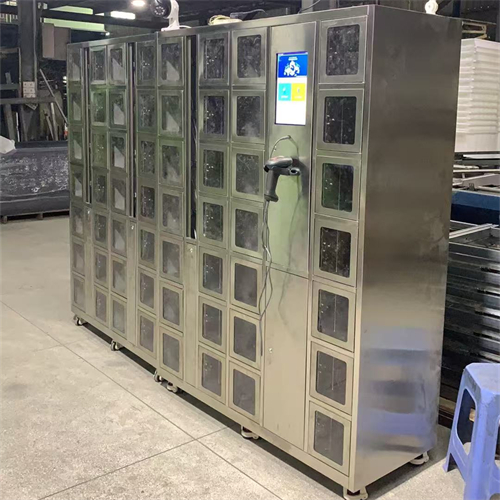Smart Material Cabinets in Factories: Revolutionizing Industrial Inventory Management
Introduction
In the era of Industry 4.0, factories are increasingly adopting smart technologies to optimize operations, reduce costs, and enhance efficiency. One such innovation is the Smart Material Cabinet, an intelligent storage system that leverages IoT (Internet of Things), RFID (Radio-Frequency Identification), AI (Artificial Intelligence), and cloud computing to automate inventory management. These cabinets are transforming traditional warehouses by minimizing human intervention, reducing errors, and ensuring real-time tracking of materials. This article explores the features, benefits, challenges, and future trends of smart material cabinets in industrial settings.

1. Key Features of Smart Material Cabinets
1.1 Automated Inventory Tracking
Smart cabinets use RFID tags or barcodes to track items in real time. Each material is logged into the system upon placement, and sensors update stock levels automatically when items are added or removed. This eliminates manual counting and reduces discrepancies.
1.2 IoT Integration
Connected via IoT, these cabinets communicate with factory ERP (Enterprise Resource Planning) or MES (Manufacturing Execution Systems) to synchronize data. Managers can monitor stock levels remotely and receive alerts for low inventory or expired items.
1.3 Access Control & Security
Biometric scanners or RFID-based authentication restrict access to authorized personnel, reducing theft or misuse. Audit trails log every transaction, ensuring accountability.
1.4 Predictive Analytics
AI algorithms analyze usage patterns to predict demand, optimize reorder points, and prevent shortages or overstocking. Machine learning improves accuracy over time.
1.5 Modular Design
Customizable shelving and compartments accommodate diverse materials (e.g., tools, chemicals, electronic components). Some cabinets include climate control for sensitive items.
---
2. Benefits of Smart Material Cabinets
2.1 Enhanced Efficiency
- Time Savings: Workers spend less time searching for parts; automated logs replace paperwork.
- Reduced Downtime: Real-time alerts ensure timely replenishment, avoiding production delays.
2.2 Cost Reduction
- Lower Labor Costs: Automation reduces the need for manual inventory checks.
- Waste Minimization: AI-driven analytics prevent overordering and obsolescence.
2.3 Improved Accuracy
- Error-Free Records: Sensors eliminate human errors in stock counts.
- Traceability: Full history of material movement aids compliance (e.g., ISO standards).
2.4 Sustainability
- Optimized inventory reduces excess storage and energy use.
- Digital records cut paper waste.
---
3. Implementation Challenges
3.1 High Initial Investment
Costs include hardware (sensors, RFID tags), software (AI/cloud platforms), and employee training. ROI justification is critical for small factories.
3.2 Integration Complexity
Legacy systems may lack compatibility with smart cabinets, requiring middleware or upgrades.
3.3 Data Security Risks
IoT devices are vulnerable to cyberattacks. Robust encryption and access controls are essential.
3.4 Workforce Adaptation
Employees may resist change. Training programs and phased rollouts can ease the transition.
---
4. Future Trends
4.1 AI & Machine Learning
- Smarter demand forecasting.
- Autonomous reordering via supplier APIs.
4.2 Blockchain for Supply Chains
Immutable ledgers will enhance transparency in material sourcing and usage.
4.3 Robotics Integration
Mobile robots or drones could fetch items from cabinets, further reducing human involvement.
4.4 Edge Computing
Local data processing (at the cabinet level) will reduce latency and cloud dependency.
---
5. Case Study: Automotive Manufacturing
A German car manufacturer implemented smart cabinets for spare parts management. Results:
- 30% faster part retrieval.
- 15% reduction in inventory costs.
- Zero stockouts during peak production.
Conclusion
Smart material cabinets represent a paradigm shift in industrial inventory management. By combining automation, IoT, and AI, they address inefficiencies inherent in traditional systems. While challenges like cost and integration persist, the long-term benefits—cost savings, accuracy, and scalability—make them indispensable for modern factories. As technology evolves, these systems will become even more autonomous, paving the way for fully "smart factories."
 RELATED
RELATED
 RELATED
RELATED
 RELATED
RELATED
 RELATED
RELATED

Fujian Haihongchuang Intelligent Technology Co., Ltd. is an IoT technology company engaged in the research and development and operation and maintenance of IoT platforms.
About

Follow us
Copyright © 2022 Suzhou Xiangyun Platform Information Technology Co., Ltd
SitemapMain business area: Beijing Suzhou
This website uses cookies to ensure you get the best experience on our website.